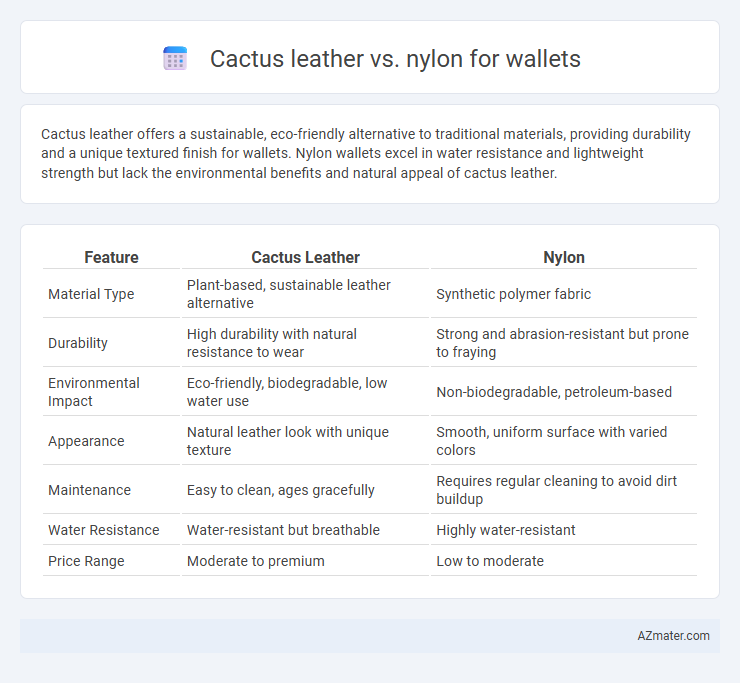Cactus leather offers a sustainable, eco-friendly alternative to traditional materials, providing durability and a unique textured finish for wallets. Nylon wallets excel in water resistance and lightweight strength but lack the environmental benefits and natural appeal of cactus leather.
Table of Comparison
| Feature | Cactus Leather | Nylon |
|---|---|---|
| Material Type | Plant-based, sustainable leather alternative | Synthetic polymer fabric |
| Durability | High durability with natural resistance to wear | Strong and abrasion-resistant but prone to fraying |
| Environmental Impact | Eco-friendly, biodegradable, low water use | Non-biodegradable, petroleum-based |
| Appearance | Natural leather look with unique texture | Smooth, uniform surface with varied colors |
| Maintenance | Easy to clean, ages gracefully | Requires regular cleaning to avoid dirt buildup |
| Water Resistance | Water-resistant but breathable | Highly water-resistant |
| Price Range | Moderate to premium | Low to moderate |
Introduction: The Rise of Sustainable Wallet Materials
Cactus leather, derived from sustainable nopal cactus leaves, offers an eco-friendly alternative to traditional wallet materials by reducing water consumption and chemical use compared to animal leather. Nylon, a synthetic polymer, provides durability and water resistance but is typically petroleum-based with a higher environmental footprint. The rising demand for sustainable wallets highlights cactus leather's biodegradable properties and renewable sourcing as key advantages over nylon in eco-conscious fashion.
What is Cactus Leather?
Cactus leather is an innovative, sustainable material made from mature leaves of the nopal cactus, processed to create a durable and eco-friendly alternative to traditional leather. Unlike nylon, which is a synthetic plastic-based fabric derived from petrochemicals, cactus leather offers biodegradability and reduced environmental impact. Its natural texture and strength make it ideal for wallets, combining style with sustainability.
Understanding Nylon: A Synthetic Staple
Nylon, a synthetic polymer made from polyamides, is renowned for its exceptional strength, flexibility, and resistance to abrasion, making it a popular choice for wallet construction. Its lightweight and water-resistant properties ensure durability and longevity in everyday use. Unlike cactus leather, nylon lacks natural texture and breathability but excels in maintaining shape and withstanding harsh environmental conditions.
Environmental Impact: Cactus Leather vs Nylon
Cactus leather boasts a significantly lower environmental footprint than nylon due to its sustainable cultivation process that requires minimal water and no pesticides, contrasting sharply with nylon's reliance on petroleum-based resources and energy-intensive production. The biodegradability of cactus leather further reduces long-term waste, while nylon's non-biodegradable nature contributes to persistent microplastic pollution. Choosing cactus leather for wallets supports reduced carbon emissions and less harmful environmental impact compared to conventional synthetic nylon materials.
Durability and Longevity Comparison
Cactus leather exhibits superior durability due to its natural resistance to scratches, water, and wear, making it an eco-friendly yet resilient option for wallets. Nylon, while strong and lightweight, tends to show signs of wear and tear faster, especially with frequent use and exposure to elements. Long-term, cactus leather wallets maintain their structure and aesthetic appeal better than nylon counterparts, ensuring extended longevity.
Aesthetic Appeal and Texture
Cactus leather offers a unique, natural grain pattern that enhances the wallet's aesthetic appeal with an organic, luxurious look, while its supple texture feels soft yet durable. In contrast, nylon wallets showcase a sleek, smooth surface with a modern, utilitarian design, providing lightweight and water-resistant properties but lacking the rich, tactile depth of cactus leather. The choice between cactus leather and nylon depends on the preference for eco-friendly, textured elegance versus practical, minimalist functionality.
Price Point and Market Availability
Cactus leather wallets typically range from $50 to $150, reflecting their status as a sustainable luxury alternative, while nylon wallets are generally priced between $20 and $70 due to mass production and lower material costs. Market availability of cactus leather wallets is growing but remains limited to niche eco-friendly brands and specialty retailers, whereas nylon wallets are widely available across both high-street and online stores. Consumer demand for plant-based, vegan alternatives drives cactus leather's premium positioning, contrasting with nylon's dominance in affordable and durable everyday wallet options.
Water Resistance and Maintenance
Cactus leather offers superior water resistance compared to nylon, as its natural, plant-based fibers repel moisture more effectively, preventing water damage and stains. Maintenance of cactus leather wallets requires occasional conditioning with plant-based oils to retain flexibility and prevent cracking, while nylon wallets are easier to clean with simple soap and water but may absorb moisture, leading to potential mold over time. Choosing cactus leather ensures durability in wet conditions with eco-friendly care, whereas nylon prioritizes low-maintenance cleaning but less water protection.
Ethical Considerations: Vegan and Eco-Friendly Benefits
Cactus leather, made from sustainable nopal cactus, offers an ethical alternative to nylon in wallet production due to its vegan composition and lower environmental impact, requiring less water and no animal exploitation. Nylon, a synthetic polymer derived from petrochemicals, involves resource-intensive manufacturing processes that contribute to pollution and non-biodegradable waste, making it less eco-friendly. Choosing cactus leather wallets supports cruelty-free fashion and reduces reliance on fossil fuels, aligning with growing consumer demand for sustainable and ethical products.
Final Verdict: Which Wallet Material Wins?
Cactus leather offers eco-friendly durability and a unique texture, making it a sustainable choice for wallets, while nylon excels in lightweight strength and water resistance. Both materials provide practical benefits, but cactus leather appeals more to environmentally conscious consumers seeking a natural alternative. The final verdict favors cactus leather for its combination of sustainability and style, though nylon remains ideal for those prioritizing versatility and budget.

Infographic: Cactus leather vs Nylon for Wallet
 azmater.com
azmater.com